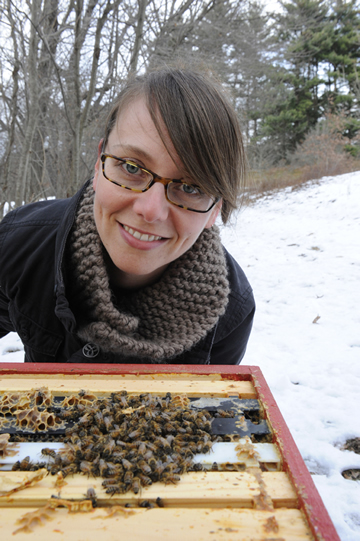The Secret Life of Bees
Wellesley’s Heather Mattila Explores Honey Bees’ “Waggle” Dancing
and Other Mysterious Behaviors
FOR IMMEDIATE RELEASE:
Jan. 25, 2010 |
|
WELLESLEY,
Mass.— How does a honey bee find its way in the world? How does it tell the other bees where it found the best food?
 |
Photo by Richard Howard |
“Working with honey bees is amazing,” said Wellesley's Heather Mattila, pictured with bees from a colony at the college's arboretum. “You can learn so much about them, but they have so many mysteries left. We still don’t understand how they work and why they do some of the things that they do.”
|
Heather Mattila, assistant professor of biological sciences at Wellesley College , studies honey bee hives to find out how colonies work together to find food. It turns out a special dance they perform offers up clues to the process.
“So often, when you have animals going out and getting food in the environment, unless you can radio track them, you don’t really know where they’ve gone,” Mattila said. “But bees come back and do a ‘waggle dance’ that lets you know exactly where they’ve been. You could put a point in a map about where they’ve gone based on the information that’s in the dance.”
Mattila’s research, recently featured in Discover Magazine, has gained importance in the agricultural arena as honey bee populations have declined dramatically — and mysteriously — in recent years. According to the U.S. Department of Agriculture, 36 percent of colonies were lost in 2007-2008 alone.
From mangoes to mustard and almonds to apples, bees pollinate more than 400 crops that would be poor producers without their services — making their decline a major concern for the health of the world’s food supply. By the latest estimates, bees in the United States add $15 billion in additional value to food supplies, contributing to about a third of our diet.
Mattila’s research has found that when queen honey bees mate with many different male bees, creating a genetically diverse colony, honey bees are better able to resist diseases. They will also forage more and communicate more about the food that they’ve found.
“Honey bees have a really sophisticated recruitment process for waggle-dancing and we know that it works a lot better when you have a lot of genetic diversity within the colony,” she said. “The bees themselves, the individual foragers, are more likely to dance, they dance longer, more bees watch their dances, and more bees leave the hive after they watch their dances.”
Sought out by beekeepers across the nation, Mattila tells them how to keep colonies healthy and maximize the genetic diversity of hives.
On the Wellesley College campus, Mattila has established 40 full-size hives, which in summer house up to 50,000 bees each. By April, Wellesley will have completed the building of a new research space that will contain nine more observation hives of about 2,000 bees each, including video equipment for each hive.
 |
Wellesley senior Morgan Carr-Markell at work on her thesis, which focuses on honey bees' waggle dancing. |
This spring Mattila will teach the course “Animal Behavior,” with Assistant Professor of Biology David Ellerby, for the first time, exploring how animal behaviors have evolved to meet the challenges of reproduction and survival — touching on topics including parental care, communication, conflict and aggression. Students will take part in labs including one on treating the notoriously aggressive Betta fish with Prozac to see how the chemical alters their behavior. They will also spend several weeks observing honeybee hives.
Wellesley senior Morgan Carr-Markell, of Shorewood, Wis., said she has always c onsidered social insects fascinating. She became involved with Mattila’s lab, and is now pursuing a thesis that focuses on the honey bees’ waggle dance.
“When a worker bee comes back to the hive after foraging, she runs around excitedly trying to attract the attention of her sister workers. When she has their attention, she begins dancing in a figure-eight pattern,” she said. “One way that foragers might attract the attention of other worker bees is by releasing pheromones, or chemical signals, from their abdomens as they dance.”
For her thesis, Carr-Markell is investigating whether worker bees from different fathers produce different amounts of these chemical signals while they dance and if these differences affect the number of followers attracted. She calls honey bee communication strategies fascinating.
“Thousands of workers all live together and support each other without any authority directing their actions,” she said. “They go out to forage, build the comb, take care of the brood, attend the queen, remove dead and diseased bees, circulate air through the hive, and, if necessary, give their lives to defend it.”
Mattila, who joined the college in January 2009, is also collaborating with Christina Grozinger of Penn State University to study chemical communication during honey bees’ swarming process. When honey bees swarm, half the colony leaves the nest with the queen and go through an intensive search for a new home. The bees have to move through the air together, always follow the queen and not get lost.
“We’re going to look at the chemicals used in that process to determine how the colony stays cohesive when they’re flying,” said Mattila, as well as why some bees leave the nest and some don’t.
While Mattila has always been interested in animal behavior, she’s always had a sweet spot for honey bees.
“Working with honey bees is amazing,” she said. “You can learn so much about them, but they have so many mysteries left. We still don’t understand how they work and why they do some of the things that they do.”
Since 1875, Wellesley College has been a leader in providing an excellent liberal arts education for women who will make a difference in the world. Its 500-acre campus near Boston is home to 2,300 undergraduate students from all 50 states and 75 countries.
###
|

